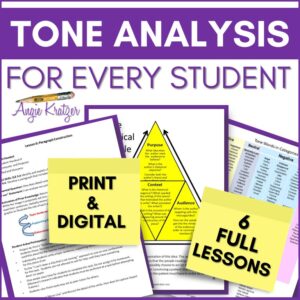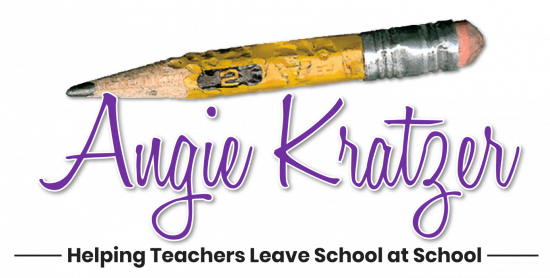Tone is my favorite thing to teach in the whole rhetorical analysis process. Because tone carries meaning, it’s the end-all, be-all. Miss the tone, miss the meaning. I spend two to three block class periods right at the beginning of first semester helping high school students wrap their heads around the nuances of tone, and these are the big chunks to my process:
Step 1 of Tone Analysis: Hook, Sort, and, Walk
- Hook: Give students an exhaustive list of tone words and have them highlight the words they know.
- Word Sort: Pairs work together to group the tone words they know into three categories: neutral, positive connotation, and negative connotation. Consider assigning a small set of words to each pair.
- Gallery Walk: On sheets of newsprint or chart paper, write the following words: happiness, sadness, anger, approval, disapproval, humor, and fear. Students cycle through all sheets and add words to the sheets. At the end of the cycle, student return to their original sheets and remove or add tone words as needed. (Students could do this exercise on sticky notes that can be removed between classes.) Students may recommend other categories. Leave the sheets posted as students begin practicing tone identification. Take the rigor up a notch by having students create the categories themselves. Students might work in small groups to arrange their sticky notes. Groups can then present and compare their categories.
Step 2 of Tone Analysis: The Vague Skit
Long story short, students have created their categorized tone word list, and I pair them up and give them this short dialogue to demonstrate how voice carries tone. Sometimes, I tell them their roles and have them choose the tone each person will use. Sometimes, I let them go wild and decide what’s happening in the conversation. They practice the skit in pairs and perform for the class.
DO NOT forget your phone on the day you do this activity. You will LAUGH are going to want to remember this lesson. Imagine the tone pair being aghast/triumphant. Now imagine it being approving/guilty. Are they talking about a heist? A good sale? A new car? A clandestine meeting? Students will have fun, and so will you.
 Person A: No, you didn’t.
Person A: No, you didn’t.
Person B: Yes, I did.
Person A: Where?
Person B: On the other side of town.
Person A: Was it expensive?
Person B: Are you kidding?
Step 3 of Tone Analysis: Image Analysis
This is where the magic happens. Step 4 will be application to written text, but it’s at Step 3 that connections happen. I have a collection of ten paintings and photographs that I project (or share for remote learning). We have whole-class discussions about how the ARTISTS feel about the SUBJECTS. It takes a while for the shift to happen, but there comes a point at which I start hearing students say, “Oh! You mean how the painter feels.” We apply that same categorized tone list to the art, and then we write about one of the photographs.
Take Leonardo da Vinci’s “Grotesque Study of Man.” This is one of the last images we analyze, and by the time we get to it, students note the mouth, nose, neck skin, and other details that illustrate the artist’s distaste. We move from da Vinci to a photograph, and that’s where I introduce writing about tone.
Here’s what I DON’T do: I don’t give the students a passage on the first day of class and ask them to tell me how the writer feels about the topic. No, we wade into this water.
Want to give this process a try? Drop your email address here, and I’ll send you six lesson plans for free. You’ll get a detailed breakdown of everything in this post.



